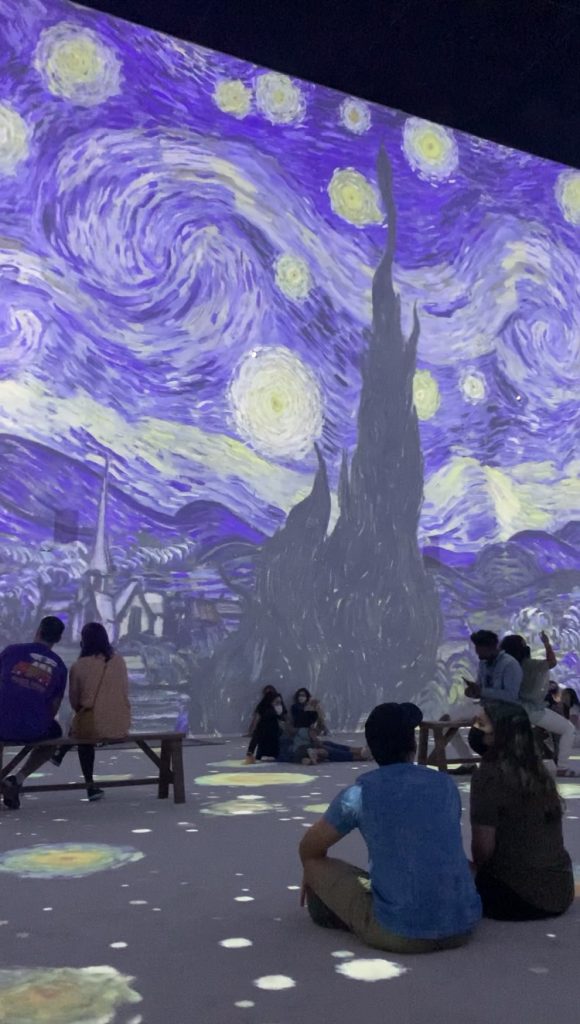“Van Gogh: the Immersive Experience” will be in Atlanta during the summer, and it’s not expected to return anytime soon. Whether you’re familiar with Van Gogh’s art, or you’ve forgotten all your art history lessons, the immersive experience will move you and connect you to a misunderstood artist who saw the world in a beautiful way. The exhibition succeeds at separating the name Vincent Van Gogh from his mental health issues, as it is usually brought up whenever he is mentioned. Van Gogh tends to be summarized by his own suffering, while this exhibit exposes the sublime beauty that lived in his heart.
It’s unnecessary to be an expert on Van Gogh to appreciate the exhibition, but it wouldn’t hurt to watch “At Eternity’s Gate” before going, as the film gives context of the artist’s life and work. You could also watch one of SCAD’s great professors, Doctor Emily Webb, talk about Van Gogh’s work on Guests and Gusto.
The immersive experience begins with Van Gogh’s series of sunflowers displayed on projections upon different canvases. They’re not the originals, but the projections are detailed enough to let you appreciate the artist’s technique and perceive his distinct use of color. The sunflowers immortalized by Van Gogh showed how something could be both beautiful and flawed at the same time, because there is nothing more natural than a flaw, and Van Gogh wasn’t afraid of showing that reality. It’s possible that he didn’t consider wilted petals as flaws, but just parts of a beautiful cycle he wanted others to appreciate.
Each segment of the exhibition features detailed descriptions of Van Gogh’s life, his influences, the misfortunes he lived through, and the public’s response to his work. People didn’t like him much back in his day. Part of me wishes Van Gogh could see that almost two centuries after his death, there are entire exhibitions dedicated to his work touring the world and drawing hundreds of visitors every day.
The most outstanding part of the immersive experience is the room of projections, where the walls become moving paintings and viewers are transported directly into Van Gogh’s mind. This is the perfect spot to sit down, relax and be carried away by an artistic narrative unlike anything you’d see in traditional museums. The room offers different seating options and people can move around as they please, because the point is for everyone to interact with the paintings however they like, either from a distance or intimately. A dramatic orchestra plays in the background throughout the different narratives of his paintings, while iconic phrases from the artist give a more personal touch to the experience. These projections showed how the integration of technology into artistic exhibitions can elevate the experience of viewing and feeling art. I never imagined I’d walk across the very same scenes of “The Starry Night” or “Wheatfield with Crows,” but the exhibition captures that feeling and makes viewers feel like small guests witnessing a sacred procession.
The final room offers the opportunity to contribute to an interactive gallery. Guests can choose from a selection of black-and-white copies of Van Gogh’s masterpieces to color with crayons as they please. It seems like a simple task, but it was one of my favorite moments of the exhibition. I couldn’t remember the last time I’d painted anything for myself, much less with crayons. I’ve never been a skilled painter, but I tried my best to color the iconic sunflowers according to my emotions at the time, adding subtle kintsugi on the vase. I spent 25 minutes coloring my sunflowers, while the 10-year-old who sat next to me colored his in ten minutes. His looked far prettier, but mine had personal meaning attached to it. It was difficult for me to paste the sunflowers on the wall along with everyone else’s artworks, but I had to, as that was the purpose of a collaborative gallery. I walked away from the tables ready to head into the overpriced gift shop and glanced back at the wall with the drawings. It looked like a chaotic mosaic with nothing cohesive to it, but it was powerful and charged with creativity, as people of all ages and backgrounds came together in one room to color and run free across Van Gogh’s artworks.






















